|
CHAPTER V
THE EGYPTIAN SACRED VOLUME-BOOK OF THE
DEAD
IN the preceding chapter I have referred to the
Egyptian Book of the
Dead.
It contains many records that prove the Motherland of Man, the
submerged continent of Mu, to have indeed been the original habitat
of mankind and that other countries were merely orbits for bodies
that moved about a center of attraction, the highly civilized
continent of Mu, colonizer of worlds that lay beyond its immediate
ken.
Consequently it does not appear to me to be out of place to say
at this point a few words about the Book of the Dead.
The Book of the Dead is the common name by which this sacred volume
is known. In Egyptian hieroglyphics the name is written : Per-m-hru.
According to Egyptologists, per means "coming forth," hru means
"day" and m is a preposition meaning "from."
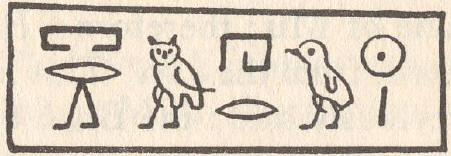
But Egyptologists are not all in accord on the exact meaning of the
title of this book.
Dr. Pleyte, in his Chapitres Supplementaires du
Livre des Marts, says the name should be read,
"going forth from the
day."
Brugsch Bey, in his Steinschrift und Bibelwort, page 257,
maintains that the correct meaning is,
"Book of the outgoing by
day."
Lefebure, Maspero and Renouf say the reading is,
"Coming forth
by day."
While these great Egyptologists are in dispute, who shall say which
is correct?
The only way the problem can be solved, it appears to
me, is to show what the book actually refers to, and what it
actually means; for all the writings composing it are symbolical,
and it is necessary to know what they symbolize. This has not been
shown by any Egyptologist up to the present time.
The Book of the Dead is a sacred memorial, dedicated to the
multitudes of people who lost their lives at the destruction of Mu,
the forefathers of the Egyptians and all mankind. These are the
"dead" referred to. This feeling of love and devotion to the
Motherland, this feeling of love and respect for forefathers, is the
origin of "ancestor worship," so common throughout the world in past
and present ages.
Have we not a reflection of it among ourselves? Do
we not lay flowers on the graves of those who have passed away?
I entirely disagree with all Egyptologists on the meaning of Per-m-hru.
Per means "gone forth"; hru means "the day" and m means Mu.
The letter m, which Egyptologists term a preposition, is nothing of
the kind: it is a symbol, the symbolic letter and also the name of
Mu; therefore: Per-m-hru reads,
"Mu has gone forth from the day."
This is in accord with what I have previously said: the Book of the
Dead is a sacred memorial to the 64,000,000 people who lost their
lives at the destruction of Mu.
My years of study in the Orient with some of the most capable of
Oriental scholars have enabled me to read many of the esoteric
meanings appearing in the Book of the Dead; for it must be
remembered that there is a close connection between the ancient
learning of India and that of Egypt.
Upper Egypt was colonized and
settled by Mayas from India, and when their settlement Maioo was
firmly established, a party of Naacals left India and went to Egypt,
to establish the teachings of the "Seven Sacred Inspired Writings,"
religion and the sciences; thus it is seen that the teachings I
received in India, to an extent, applied also to Egypt.
At what date the Book of the Dead was first formed is unknown;
apparently, however, the first copies contained only a few chapters,
which were subsequently added to until it assumed the proportions in
which we now find it. In this respect it has been a duplication of
the Hindu book, Maha Bharata, which commenced small and grew large
with time.
Every chapter in the Book of the Dead either directly or indirectly
refers to Mu, and the book is permeated with symbols which were
assigned to Mu before the foot of man trod the soil of Egypt.
As stated, Mu was first torn to pieces by earthquakes and then sank
through the flames of the underneath into a fiery abyss or caldron.
I shall now take a few vignettes from the Book of the Dead, decipher
and translate them, to show the connection between the Book of the
Dead and Mu, the Motherland.
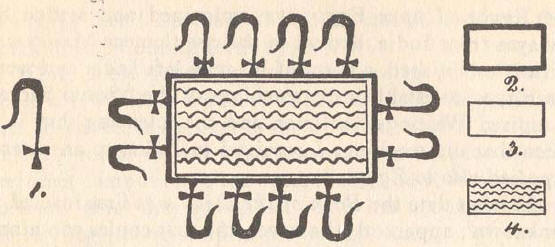
Vignette I. This is an Egyptian compound symbol or vignette
describing Mu's destruction. Found in the Book of the Dead.
1. Is the Egyptian symbol for flames of fire.
2. Is the hieratic letter M of the Motherland and her alphabetical
and geometrical symbol, and one of the most commonly used symbols
for her.
3. Is an ancient symbol, depicting an abyss, a tank or a pit.
4. Is this tank or abyss filled with fire.
Thus the vignette reads:
"Mu has gone down into an abyss of fire,
and, as she sank, flames of fire shot up around her and enveloped
her."
This is told by flames being set all around Fig. 2 - Mu.
One of the most prominent symbols, on account of its being so oft
repeated, is a conventional altar, over which is a set sun, and
above the sun a dead closed lotus.
This compound symbol is found scores of times among the vignettes of
the Book of the Dead, and a notable fact is that the lotus is
invariably depicted as dead and closed, throughout the book.
I will decipher and translate this little vignette:
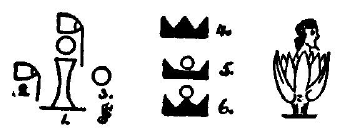
1. Is the Egyptian conventional form of an altar.
2. Is the sacred lotus flower, the sacred floral symbol of Mu.
3. Is the sun without rays, symbolizing that the sun has set, gone
down beyond the horizon. Being placed below Mu, the lotus, it
symbolizes that the sun has dropped below the horizon of Mu. The sun
has forever set on dead Mu. All is darkness. Mu is in "the region of
darkness." Before the submersion of Mu her common goegraphical
symbol was a three-pointed figure (Fig. 4), reading, "The Lands of
the West," the three areas of land which composed the Motherland.
After Mu was submerged, her geographical location was called "the
region of darkness," and in this condition she was symbolized by
placing a sun without rays over the center point (Fig. 6).
Occasionally the center point was cut out altogether and a rayless
sun substituted.
The Vignette of Chapter 81. In the Book of the Egyptologists have
described this vignette as "a head peeping out of a lotus flower."
The last line of the eighty-first chapter reads:
"I am a pure Lotus
sprung out of the Field of the Sun."
The deciphering of this vignette is:
The head represents an Egyptian and Egyptians, as shown by the
headdress.
The head has arisen out of a lotus.
The lotus is shown as dead and closed.
In this vignette the lotus is dead Mu.
Translated it reads:
"The Egyptians came from Mu, a land which is dead and exists no
more."
The last line is the crux of the whole chapter.
"I am a pure lotus" means: "I am a pure descendant from the people
of Mu."
"Sprung from the Field of the Sun" corroborates the lotus.
"The
Field of the Sun" also means the Empire of the Sun, the imperial
name of Mu.
Mu in the tongue of the Motherland meant: "mother, land, field,
country, empire" and "mouth."
A free reading of this vignette would be:
"I am an Egyptian of pure
descent; my forefathers came from the motherland Mu, the Empire of
the Sun, which is now dead and gone."
Space will not permit me to decipher more vignettes from the Book of
the Dead. A large volume could be filled with them.
I will make one more note, which is all Egyptian, but only partially
from the Book of the Dead.
All ancient peoples, including the Egyptians, believed in the
reincarnation of the soul. Our old Oriental tablets showed us that
the ancients understood the origin and the workings of all the
forces: they knew that when a force had done its allotted duty, that
which had been assigned to it by nature, it became exhausted, but
not dead.
A force cannot die any more than an element can die. An
exhausted force is drawn back to the source of generation for
regeneration, then to be passed into nature's storehouse, there to
await the next call from nature. This is what the old tablets tell
us.
Man's soul is the greatest force connected with the earth except
that of the Deity. The soul of man was incarnated in the land of Mu,
the Lands of the West. When man's body sleeps its last sleep and
decomposes, his soul does not die with the body, but, the ancients
believed, returns to the place of incarnation, Mu, there to await
reincarnation.
From the time of Menes, when Upper and Lower Egypt became one
kingdom, down to about 2700 B. C., there were two religious cults in
Egypt, known as the West cult and the East cult. The belief of the
Lower Egyptians was that the soul traveled west to reach the place
of reincarnation. The Upper Egyptians claimed that the soul must
travel east to reach a celestial paradise.
Both cults claimed that
the soul must travel back over the same road, to the place of
reincarnation, by which their forefathers came to Egypt.
When looking at the foregoing and reading the speculations of
professional Egyptologists concerning these diametric cults, one is
tempted to smile, for I have failed to find a single Egyptian
authority who explains the origin and cause of these two cults,
which at one time existed in Egypt; yet the problem is easy to
answer, as the following will prove:
-
Lower Egypt was settled from the Motherland via Mayax and Atlantis,
both of which lay to the west of Egypt; therefore, to reach the
place of reincarnation from Lower Egypt, and to travel back over the
same road by which their fathers came, the soul had to travel back
to the west.
-
The Upper Egyptians came to Egypt from the Motherland by way of
Burma and India. Both of these countries lie to the east of Egypt;
so that for the souls of the Upper Egyptians to arrive at the place
of reincarnation and to travel back over the same road by which
their fathers came, they had to travel back to the east.
So it is
seen that both cults were right, although it took them many hundreds
of years to find it out.
Donald A. Mackenzie:
"The fusion of the two ancient Egyptian cults,
that of Osiris, which originally believed in a paradise in the west,
and that of the sun-worshipers, who believed in a celestial paradise
in the east."
"Osiris, an ancient deified king, was identified with the gods of
the western cult."
"The early conflict between the two cults is echoed in the mortuary
texts, dating back till about 2700 B.C."
Like all Egyptologists, Mackenzie is sadly deficient in symbology.
All fail to differentiate between the symbol and what it represents.
They fail to remember that the ancients used a special symbol for
every attribute of the Deity, and that the sun was the collective
symbol of all the attributes of the Deity, and therefore represented
the Deity Himself.
The Upper Egyptians were not sun-worshipers, as stated by Mackenzie.
Ra, the sun, was their collective symbol for the Deity. Temples were
dedicated to Ra as representing the Divinity, just as the cross
today represents Christ.
A symbol is an intimate reminder, mentally concentrating and
bringing in closer touch and mental view the object addressed. With
the use of symbols many encroaching outside thoughts are driven
away. A symbol permits of greater concentration.
Mackenzie asserts that Osiris was an ancient king. What people he
reigned over Mackenzie does not say, but by inference it would be
the Egyptians; if so, he is wrong again, because when Thoth started
the first Lower Egyptian colony at Sais, he taught the Osirian
religion, as various papyri show, and that was 16,000 years ago.
From two different sources I find it stated that Osiris lived in
Atlantis 18,000 or 20,000 years ago, and that he was a great
religious teacher - a master.
The two Egyptian cults form another convincing proof that the advent
of man on earth was on Mu, and that Mu was situated in the Pacific.
The geographical position is thus positively established as east of
Burma and west of Mayax and, therefore, in the Pacific Ocean.
The destruction of the Motherland was also commemorated in their
religious ceremonies. The advancement of the novice through the
second degree was by symbolically submerging him in a tank of fire
to remind him of the fate that befell his forefathers in the beloved
Motherland, and also to hint where his soul must go for
reincarnation.
This is reflected in the Book of the Dead, Chapter
22, where it says:
"I come, I do that which my heart wishes on the
day of the Fire, when I extinguish the flames as soon as they
appear."
Before closing my section on records, I think it advisable to show
corresponding records from all areas surrounding the Pacific Ocean.
This will help readers fully to grasp the situation and the facts.
I will first take the symbol, the Royal Escutcheon of Mu, the Empire
of the Sun - a sun with eight rays.
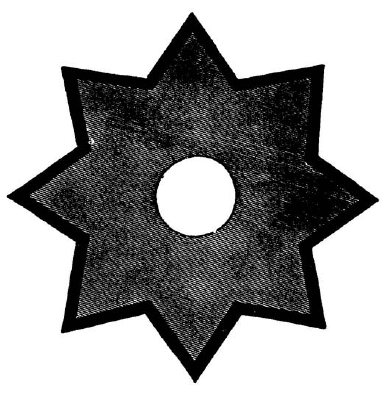
The particular design here given was found on the dress of a
Kootenay Indian living in British Columbia.
The border of the dress
of another Kootenay Indian was composed of a continuation of one of
the symbols of "Mu submerged" (see page 124). The garment with the
sun symbol was black, the sun in pale yellow, the points of the rays
in pale indigo blue and the intervening space between the sun and
the points of its rays a pale reddish pink.
Among the Indians of the northwestern section of North America are
found the now famous totem pillars, the original meaning of which I
give on page 155.
-
On page 64 I showed a picture of the Royal Escutcheon of Mu painted
on the fan of one of the savages of the Gilbert Islands, 7000 miles
from British Columbia.
-
On page 97 I noted the totem poles of the Maoris of New Zealand,
12,000 miles from the Kootenay Indians.
-
On page 204 I will show symbols among the Nevada cliff writings that
referred to Mu, also in New Mexico, and again in Niven's "Mexican
Buried Cities," page 228, and in "Yucatan," page 262.
A vast impenetrable forest of dense tangled tropical jungle growth
covers the southern half of Yucatan and extends far into Guatemala,
which is half covered by it. It extends into Chiapas and Tabasco,
and stretches into Honduras.
This great forest is not primeval, for
once the land was densely populated with great cities and highly
cultivated fields. Throughout this now impenetrable wilderness are
ruins, great imposing ruins, and, if we can believe the tales of the
Indians, Copan and Quirigua, which are on the outer edge of this
luxuriant jungle, are only samples of still greater ruins hidden
away in the forest depths and lying beyond the present reach of the
white man.
Personally I believe the tales of the Indians to be true, for they
talked about these ruins with superstitious awe, which lent credence
to their tales. Beyond the tales of the Indians, we have Egyptian
records confirming them.
The forest is part of "the country beyond," which was made a ruin
and "impassable" with the loss of "nearly all the people" by great
"cataclysmic floods which rolled over the land."
This civilization was wiped out and its cities wrecked between
11,500 and 11,750 years ago, when the gas belts, which run under and
around this area, were being forged, with the attendant mountain
raising, a little while before the submersion of Atlantis.
For the Egyptians to say the country was impassable, after such
devastating phenomena, is certainly a mild way of describing the
conditions.
At Copan in Honduras, Quirigua in Guatemala, Opico and
Cirraca-Mecallo in Salvador, there are enormous prehistoric ruins.
In all these ruins one finds symbols referring to Mu.
At Quirigua there are some notable stelai or obelisks, 13 in number,
which have symbolical human figures carved upon them, each wearing a
triple crown, thus showing their allegiance to the Motherland.
Each of these stelai has a different totem symbol, showing they
refer to various dynasties of kings. Each of the ancient dynasties
had a different totem, such as the Elephant, Tiger and Serpent.
Thus it is shown that a continuous string of records exists from end
to end of the western parts of North, Central and South America, all
telling us that Mu was their Motherland.
I have noted symbols among the savages of the South Sea Islands and
on the stones of the ruins among these specks of land. I then went
from the South Pacific to New Zealand, so that nothing remains but
Asia to complete the circuit around the ocean.
Burma and India are
full of records about Mu, as I have heretofore prominently shown,
corresponding in all details with those of America.
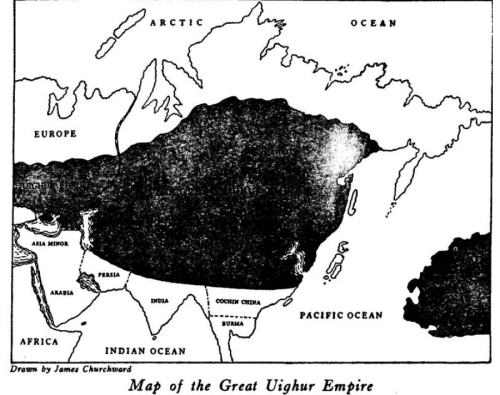
I think the Uighur records will be all that is necessary to convince
the most skeptical mind that it is clearly proven by symbols alone
that Mu was the Motherland of Man.
The Uighur was the principal colonial empire belonging to Mu at the
time of destroyed its eastern half.
The Biblical "Flood," which Chinese legends tell that the Uighurs
were at the height of their civilization about 17,000 years ago.
This date agrees with geological phenomena.
The Uighur Empire stretched its powerful arms from the Pacific Ocean
across Central Asia and into Eastern Europe from the Caspian Sea on.
This was before the British Isles became separated from the
continent of Europe.
The southern boundary of the Uighur Empire was along the northern
boundaries of Cochin China, Burma, India and Persia, and this was
before the Himalayas and the other Asiatic mountains were raised.
Their northern boundary extended into Siberia, but how far there is
no record to tell. Remains of their cities have been found in the
southern parts of Siberia.
Eventually the Uighurs extended themselves into Europe around the
western and northern shores of the Caspian Sea, as related in a very
ancient Hindu record; from here they continued on through Central
Europe to its western boundary, Ireland.
They settled in northern Spain, northern France, and far down into
the Balkan region. The late archaeological discoveries in Moravia
are Uighur remains, and the evidences on which ethnologists have
based their theories that man originated in Asia have been marks
left by the advancing Uighurs in Europe.
The history of the Uighurs is the history of the Aryans.
Ethnologists have classed certain white races as Aryans that are not
Aryans at all, but belong to a totally different line of
colonization.
The capital city of the Uighurs was where the ruins of Khara Khota
now stand in the Gobi Desert. At the time of the Uighur Empire the
Gobi Desert was an exceedingly fertile area of land.
The Uighurs had reached a high state of civilization and culture;
they knew astrology, mining, the textile industries, architecture,
mathematics, agriculture, writing, reading, medicine, etc. They were
experts in decorative art on silk, metals and wood, and they made
statues of gold, silver, bronze and clay; and this was before the
history of Egypt commenced.
About one-half of the Uighur Empire was destroyed before Mu went
down, the other half subsequent to Mu's submersion.
Professor Kosloff unearthed a tomb 50 feet below the surface at
Khara Khota and in it found wonderful treasures, which he
photographed, not being allowed to disturb or take anything away.
Through the courtesy of the American Weekly I have obtained the loan
of some of these pictures, two of which I here reproduce with their
decipherings.
I think I am safe in believing that these pictures
represent a time between 16,000 and 18,000 years ago (halftones
between pages 160-1).
These pictures are symbolical, the various symbols telling who they
are, and what they are. In the original they are paintings on silk
and represent a queen and her consort in a sitting posture. I will
now pick out the symbols of the Queen. On her head is a
three-pointed crown with a disc in the center with three sets of
rays emanating from it. Behind her body is a large disc, the sun.
At
the back of her head is a smaller disc, an inferior sun. The large
disc symbolizes Mu, the small disc the Uighur Colonial Empire. The
crown on her head, a sun with rays on one half only, shows the
escutcheon of a colonial empire. In her left hand she carries a
scepter, the ends of which are in the form of a trident - three
points - the Motherland's numeral.
Her seat is a full-blown sacred lotus, the floral symbol of the
Motherland, so that she is depicted as sitting in the lap of and
being upheld by Mu, the Motherland. Her consort does not carry a
scepter, nor has he a sun with rays, but in its place a sphere. His
crown also shows the Motherland's numeral.
Kosloff had pictures of various scepters. This illustration is of a
different pattern from the one held in the queen's hand, and of
later date, but symbolically reads the same, the ends being divided
into three giving the numeral of the Motherland.
Thus we see the symbols of Asia, America, South Sea Islands and New
Zealand all agreeing in the tale they tell.
Could anything be more
definite or convincing - unless our old forefathers were to rise
from their graves, to tell us by word of mouth what happened to them
in the land of Mu?
Back to Contents
|




